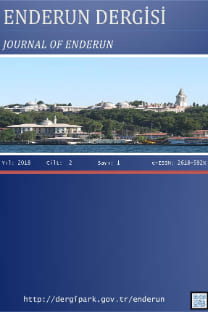TÜRKİYE’DE EĞİTİM HARCAMASI VE EKONOMİK BÜYÜME: ARDL SINIR TESTİ
Eğitim harcamaları, ekonomik büyüme, Granger nedensellik, ARDL
EDUCATION EXPENDITURE AND ECONOMIC GROWTH IN TURKEY: ARDL BOUND TESTING
Education expenditures, economic growth, Granger causality, ARDL,
___
- Ay, A. ve P. Yardımcı.(2008).Türkiye’de Beşeri Sermaye Birikimine Dayalı Ak Tipi İçsel Ekonomik Büyümenin Var Modeli ile Analizi (1950–2000), Maliye Dergisi, 155, ss.39–54.
- Balaev, M. (2014). Improving models of democracy: the example of lagged effects of economic development, education, and gender equality. Social science research, 46, 169-183.
- Bozkurt, H. (2010), Eğitim, Sağlık ve İktisadi Büyüme Arasındaki İlişkiler: Türkiye İçin Bir Analiz. Bilgi Ekonomisi ve Yönetimi Dergisi 5 (1), ss.7-27.
- Burja, C. ve Burja, V. (2013). Education's contribution to sustainable economic growth in Romania. Procedia-Social and Behavioural Sciences, 81, 147-151.
- Cheong Cheng, Y., Cheung, A. C. ve Yeun, T. W. (2011). Development of a regional education hub: The case of Hong Kong. International Journal of Educational Management, 25(5), 474-493.
- Çalışkan, Ş., Karabacak, M., ve Meçik, O. (2013). Türkiye’de eğitim-ekonomik büyüme ilişkisi: 1923-2011 (Kantitatif bir yaklaşım). Yönetim Bilimleri Dergisi, 11(21).
- Erdoğan, S. ve D. Ç. Yıldırım .(2009) Türkiye’de Eğitim–İktisadi Büyüme İlişkisi Üzerine Ekonometrik Bir İnceleme, Bilgi Ekonomisi ve Yönetimi Dergisi, 4(2), ss.11-22.
- Eriçok, R. E. ve V. Yılancı (2013).Eğitim Harcamaları Ve Ekonomik Büyüme İlişkisi: Sınır Testi Yaklaşımı. Bilgi Ekonomisi ve Yönetimi Dergisi, 8(1),ss.87- 101.
- Granger, C.W., (1969). Investigating causal relations by econometric models and cross-spectral methods. Econometrica 37, 424–438.
- Guilkey, D.K., Salemi, M., (1982). Small sample properties of three tests for Grangercausal ordering in a bivariate stochastic system. Review of Economics and Statistics 64, 668–681.
- Kar, M. ve H. Ağır.(2003).Türkiye’de Beşeri Sermaye Ve Ekonomik Büyüme: Nedensellik Testi, II. Ulusal Bilgi, Ekonomi ve Yönetim Kongresi Bildiriler Kitabı, 181-190.
- Karataş, M. ve E. Çankaya (2011), Türkiye’de Beşeri Sermaye ve Ekonomik Büyüme İlişkisinin Analizi. Yönetim ve Ekonomi: Celal Bayar Üniversitesi İktisadi ve İdari Bilimler Fakültesi Dergisi, 18(1), ss.105-214.
- Kızılkaya, O. ve E. Koçak ; (2014). Kamu Eğitim Harcamaları Ve Ekonomik Büyüme İlişkisi: Seçilmiş OECD Ülkeleri Üzerine Bir Panel Veri Analizi. Ekonomi Bilimleri Dergisi, 6(1), ss.18-32.
- Manafi, I. ve Marinescu, D. E. (2013). The Influence of Investment in Education on Inclusive Growth-Empirical Evidence from Romania vs. EU. Procedia-Social and Behavioural Sciences, 93, 689-694.
- Mercan, M. ve S. Sezer.(2014).The Effect Of Education Expenditure On Economic Growth: The Case Of Turkey. Procedia-Social and Behavioral Sciences, 109,pp.925- 930.
- Narayan, P.K., (2005). The saving and investment nexus for China: evidence from cointegration tests. Applied Economics 37, 1979–1990.
- Özsoy, C. (2009), Türkiye’de eğitim ve iktisadi büyüme arasındaki ilişkinin var modeli ile analizi. The Journal of Knowledge Economy & Knowledge Management, 4, ss.71-83.
- Pamuk, M. ve H. Bektaş (2014).Türkiye’de Eğitim Harcamaları ve Ekonomik Büyüme Arasındaki İlişki: ARDL Sınır Testi Yaklaşımı. Siyaset, Ekonomi ve Yönetim Araştırmaları Dergisi, 2(2),ss.77-89.
- Pesaran, M., Shin, Y., Smith, R., (2001). Bounds testing approaches to the analysis of level relationships. Journal of Applied Econometrics 16, 289–326.
- Sánchez, M. V., ve Cicowiez, M. (2014). Trade-offs and payoffs of investing in human development. World Development, 62, 14-29.
- Sari, R., ve U. Soytas; (2006), “Income And Education İn Turkey: A Multivariate Analysis.”, Education Economics, 14(2), ss.181-196.
- Saygılı, Ş. Cihan C., ve Z. Yavan. (2005), Human Capital And Productivity Growth: A Comparative Analysis Of Turkey, METU Studies in Development, 32(2), pp.489- 516.
- Serel, H. ve K. Masatçı; (2005), “Türkiye’de Beşeri Sermaye Ve İktisadi Büyüme İlişkisi: Ko-Entegrasyon Analizi.” Atatürk Üniversitesi İktisadi ve İdari Bilimler Dergisi 19 (2), ss.51-58. Singer, Hans W; (1961), Education And Economic Development , International Development: Growth and Change.
- Şimşek, M. ve C. Kadilar (2010), Türkiye’de Beşeri Sermaye, İhracat Ve Ekonomik Büyüme Arasındaki İlişkinin Nedensellik Analizi. C.Ü. İktisadi ve İdari Bilimler Dergisi, 11(1), ss.115-140.
- Tilak, J. B. (2011). Financing higher education in Sub-Saharan Africa. Africanus, 41(2), 4-31.
- Uçan, O. ve H. Yeşilyurt. (2016). Türkiye’de Eğitim Harcamaları Ve Büyüme İlişkisi. Ömer Halisdemir Üniversitesi İktisadi Ve İdari Bilimler Fakültesi Dergisi, 9(2), ss.179-185.
- Yardımcıoglu, F., T. Gürdal and M. E. Altundemir; (2014).Education and Economic Growth: A Panel Cointegration Approach in OECD Countries (1980- 2008). Egitim ve Bilim, 39(173), ss.1-12.
- ISSN: 2618-592X
- Yayın Aralığı: Yılda 2 Sayı
- Başlangıç: 2017
- Yayıncı: Cihan USTA
KİTAP İNCELEMESİ: BABİL’İN ÖNCESİ, BİTCOİN’İN ÖTESİ: BİZİM ANLADIĞIMIZ PARADAN BİZİ ANLAYAN PARAYA
OSMANLI’DAN GÜNÜMÜZE YEREL HİZMET SUNAN KLASİK KURUMLARIN DÖNÜŞÜMÜ
SAVUNMA, EĞİTİM VE SAĞLIK HARCAMALARI ARASINDAKİ NEDENSELLİK ANALİZİ: D-8 ÜLKELERİ ÖRNEĞİ
ESNEK AKIŞ TİPİ ÇİZELGELEME PROBLEMİ ÜZERİNE LİTERATÜR TARAMASI
TÜRKİYE’DE EĞİTİM HARCAMASI VE EKONOMİK BÜYÜME: ARDL SINIR TESTİ
